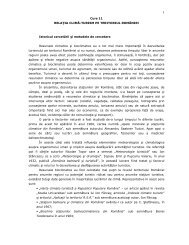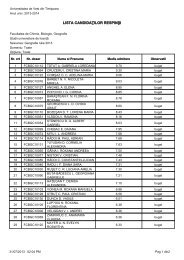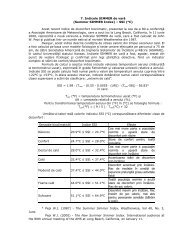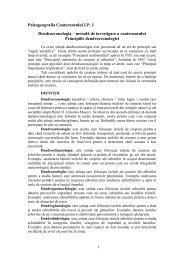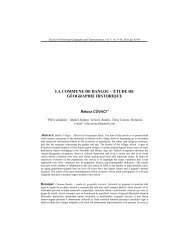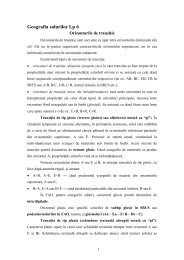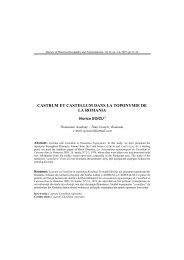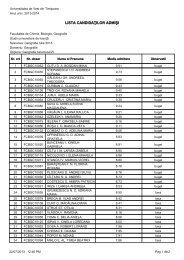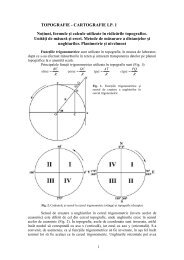paper in English - Departamentul de Geografie
paper in English - Departamentul de Geografie
paper in English - Departamentul de Geografie
Create successful ePaper yourself
Turn your PDF publications into a flip-book with our unique Google optimized e-Paper software.
Settlement history and susta<strong>in</strong>ability <strong>in</strong> the Carpathians <strong>in</strong> the eighteenth and n<strong>in</strong>eteenth centuriesforce dur<strong>in</strong>g the best part of a century: 1762-1851. Popa 1999 (p.216) has expla<strong>in</strong>ed how‘Regimentul Românesc 1 Orlat’ had a company <strong>in</strong> Haţeg which offered advantages foreducation and tra<strong>in</strong><strong>in</strong>g - through privileges <strong>in</strong> the relevant villages - which helped tocounter the marg<strong>in</strong>alisation of this mounta<strong>in</strong> <strong>de</strong>pression through the <strong>de</strong>parture of nobleRomanian families. However it is the northeastern Rodna Military District - later NăsăudFrontier District - that has been most extensively researched (Sotropa 1975). A total of 12Companies were formed dur<strong>in</strong>g 1762-83 with each recruited from a group of villages andthe special regime lasted until a civil adm<strong>in</strong>istration was provi<strong>de</strong>d <strong>in</strong> 1851. Năsăud was thengranted autonomy <strong>in</strong> 1861 but this was cancelled when Hungary became responsible foradm<strong>in</strong>istration un<strong>de</strong>r the compromise (‘Ausgleich’) of 1867 between the Habsburg emperorand the Hungarians and the county (‘comitat’) of Bistriţa-Năsăud was created.Un<strong>de</strong>r military plann<strong>in</strong>g there was a consolidation of the Greek-Catholic parochialstructure and provision of a state education system through elementary ‘Trivialschulen’from 1770 and a high school (‘Şcoala Normală Superioară’) <strong>in</strong> Năsăud <strong>in</strong> 1771 (Albu1971). Medical and sanitary programmes provi<strong>de</strong>d effective barriers aga<strong>in</strong>st the spread ofplague from Moldavia <strong>in</strong> 1815 and cholera from Wallachia <strong>in</strong> 1830 (Buta & Pupeza 1994).Commerce expan<strong>de</strong>d <strong>in</strong> a network of central places with their fairs and road systems, whilethe promotion of agriculture <strong>in</strong>clu<strong>de</strong>d attention to cereals, vegetables, potatoes, textileplants and fruit trees, along with stock rear<strong>in</strong>g and allocation of graz<strong>in</strong>gs (Mureşianu 2000pp.182-6). In<strong>de</strong>ed this is the basis of landhold<strong>in</strong>g today apart from some abusive transfersto non-frontier communes <strong>in</strong> the communist period. Regulation exten<strong>de</strong>d to hunt<strong>in</strong>g andfish<strong>in</strong>g as well as forestry, m<strong>in</strong><strong>in</strong>g and manufactur<strong>in</strong>g; with the latter facilitated through<strong>in</strong>struction <strong>in</strong> sp<strong>in</strong>n<strong>in</strong>g, weav<strong>in</strong>g and full<strong>in</strong>g, and a growth of water-powered cereal mills aswell as the first ‘joagare’ <strong>in</strong> Maieru and Parva <strong>in</strong> 1766. Beer and spirits were produced <strong>in</strong>Năsăud from 1765, <strong>paper</strong> at Prundul Bârgăului from 1768 while a great lime furnace('varniţa') was built at Parva <strong>in</strong> 1777. It is also notable that settlement was consolidated sothat Nepos was transformed between 1775 and 1783 from a scattered settlement north ofthe river Someş to a compact l<strong>in</strong>ear belt along the ma<strong>in</strong> valley. In the same way Budacu <strong>de</strong>Sus emerged as an expand<strong>in</strong>g nucleated settlement complement<strong>in</strong>g the exist<strong>in</strong>g Germannucleation of Budacul Săsesc (or Budacu <strong>de</strong> Jos). New settlement occurred <strong>in</strong> the heavilyforested Ilva valley as colonists moved from Maieru and Rodna to establish dispersedcommunities at Arşiţa, Recele and Secături before consolidat<strong>in</strong>g un<strong>de</strong>r the frontier régimeas Poiana Ilvei, Magura Ilvei and Ilva Mare. From the ‘m<strong>in</strong>i-bas<strong>in</strong>s’ along this secondarymorpho-hydrographic axis the meadows and forests on the high surfaces could be morefully utilised (Mureşianu 1996).THE NINETEENTH CENTURY: THE RAILWAY AGEDur<strong>in</strong>g this period territorial stability, rest<strong>in</strong>g on Habsburg dom<strong>in</strong>ance, wasconsolidated through a secret treaty with Romania, although the ‘Ausgleich’ (mentionedabove) created tension through the re-emergence (albeit with<strong>in</strong> the empire) of a Hungariannation state with<strong>in</strong> a large multi-ethnic territory. The potential for growth was <strong>in</strong>creased bythe end of feudalism <strong>in</strong> the empire <strong>in</strong> 1848 (and Romania <strong>in</strong> 1864) which opened the wayfor a more unrestra<strong>in</strong>ed capitalism as the peasants now found themselves un<strong>de</strong>r a more<strong>de</strong>mand<strong>in</strong>g fiscal pressure without the same customary access to forest and graz<strong>in</strong>g land. Atthe same time, given the capitalistic rivalries of sovereign states, it can be seen that while41


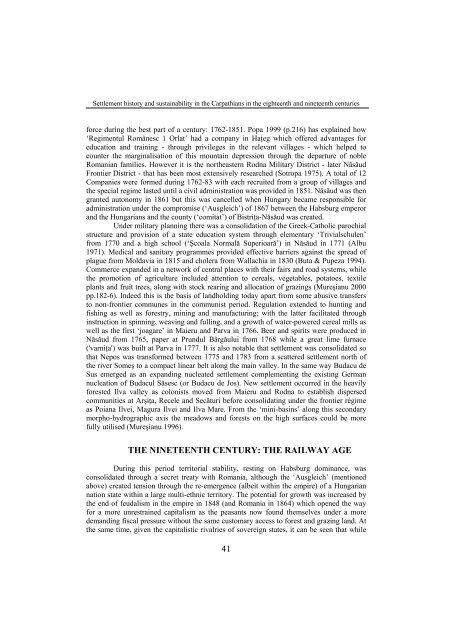
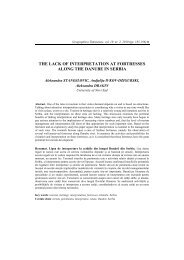

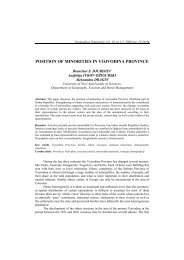
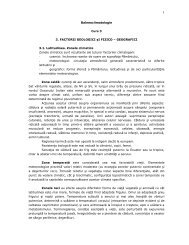
![in Romanian [pdf]](https://img.yumpu.com/51065862/1/184x260/in-romanian-pdf.jpg?quality=85)
